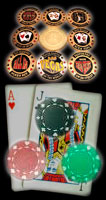EVALUATING THE FLOP
The first step in playing the flop is an evaluation of your prospects.
Let’s look at situations where the flop is:
![]() A virtually worthless hand
A virtually worthless hand
![]() A probable big winner
A probable big winner
![]() A probable winner
A probable winner
![]() A probable best hand with large loss potential
A probable best hand with large loss potential
![]() A strong draw
A strong draw
![]() A probable best hand with a strong draw
A probable best hand with a strong draw
![]() A weak draw
A weak draw
![]() A steal opportunity
A steal opportunity
Let’s focus on how to recognize and evaluate the hand you’ve just flopped.
The skill to quickly assess how the flop has affected your hand’s moneymaking
potential rather than its poker hand value is an important skill.
The actual value of various kinds of flops is highly dependent on the game conditions, that is, the loose-tight and passive-aggressive characteristics of your table.
Defining Your Hand
The flop defines your hand. Before the flop you have two cards that may or may not develop into a poker hand. Once the flop hits, you have a hand.
You still have two more cards coming to complete your hand, but the possibilities are defined and limited by the flop.
Most poker books discuss your hand at this stage of the betting only in terms of its poker value.
Poker value is, of course, important.
We discussed that in the last chapter. In Holdem, however, a hand’s potential to win money isn’t always related to its poker value.
The phrase “texture of the flop” is often used to refer to how the flop cards combine with your hand and other players’ cards to determine your moneymaking or money-losing potential.
Here’s an example: Say you start with A ![]() K
K ![]() . That’s a very good starting hand.
. That’s a very good starting hand.
Its value as a starting hand comes from the wide range of possibilities of the hand.
It can develop into a high pair, a nut flush, a nut straight, or nothing at all.
Which possibility is realized won’t be determined until you see the three cards on the flop.
A list of example flops follows:
10 ![]() 9
9 ![]() 8
8 ![]()
A ![]() K
K ![]() 7
7 ![]()
A ![]() 10
10 ![]() 10
10 ![]()
A ![]() 9
9 ![]() 5
5 ![]()
Q ![]() J
J ![]() 5
5 ![]()
A ![]() 10
10 ![]() 5
5 ![]()
J ![]() 10
10 ![]() 7
7 ![]()
9 ![]() 5
5 ![]() 2
2 ![]()
Each of these flops makes A ![]() K
K ![]() a very different hand.
a very different hand.
Before you proceed you might want to stop and determine into which of the eight categories of hands each of these flops fits best.
Don’t memorize the categories. The particular categories don’t matter as much as the idea of looking at the hand’s money potential rather than its poker rank.
Pick the Right Table / Picking a Seat / Theories of Poker / Betting Theory: The Odds
A Theory of Starting Hand Value
A Theory of Flop Play: Counting Outs and Evaluating Draws
The Dynamics of Game Conditions / Table Image / Player Stereotypes
Women and Poker / Spread-Limit Games / Double Bet on the End Games / Kill Games
Short-handed Games / Tournaments / No-limit and Pot-Limit Poker



